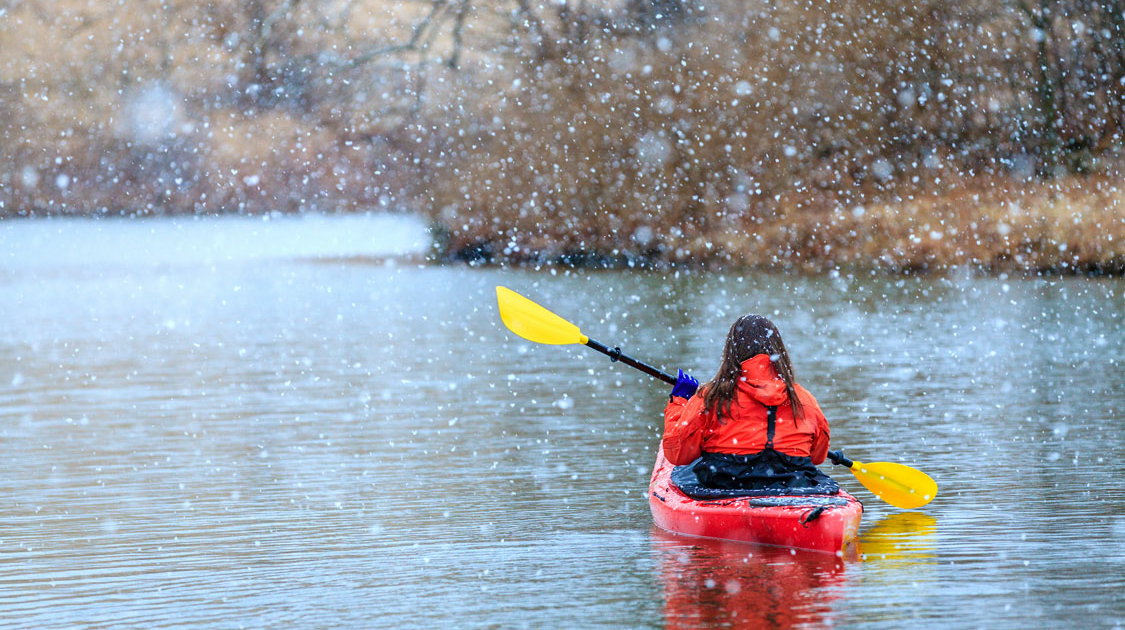Cold Weather, Cold Water Paddling Safety Tips
How to stay safe when the water is cold
We’ve been cooped up all winter and many of us are itching to get back on the water. Before you venture out on the Huron River or any waterbody in the preseason cold, there are additional safety precautions you should take.

Paddling in your kayak or canoe or using your SUP in cold weather or on cold water, especially during parts of the year when temperatures can fall near or below freezing, gives you much less room for mistakes before you can find yourself in catastrophic circumstances. Hypothermia and drowning are a perilous mix. Immersion in cold water can lead to the rapid onset of hypothermia, which can make you lose control of your muscles and become unable to get back in a boat or to shore.
Temperatures of the Huron River in April
April water temperatures measured in the Huron River in Scio Township and at Lower Huron Metropark 2015-2018 were as low as 38 degrees Fahrenheit. The April average daily minimum temperature measured 48-49. The average daily maximum temperature was 50-52 degrees.
Not convinced you need to be concerned?
Here is some information from the American Canoe Association about cold water paddling:
Cold Water
Cold water is extremely dangerous. It quickly robs the body of its strength, diminishes coordination and impairs judgement. Immersion in water as warm as 50-60 degrees can initiate what has been determined to be “Cold Water Shock.” When a paddler capsizes and is suddenly immersed in cold water the body’s first reflexive action is to gasp for air, followed by increased heart rate, blood pressure and disorientation, and can even lead to cardiac arrest. Without proper equipment and apparel, the body can become incapacitated in just a few minutes, and without a lifejacket this can be a very dangerous and often fatal combination. When paddling in places where the water temperature is 60 degrees Fahrenheit or colder, a wetsuit is a must and a drysuit is highly recommended. This is also the case if the combined air and water temperatures are below 120 degrees Fahrenheit.
Another dangerous situation that can occur in cold water or cold weather is hypothermia. Hypothermia occurs when exposure to the elements prohibits the body from reheating and maintaining its core temperature. Typical symptoms of hypothermia include: shivering, impaired judgment, clumsiness, loss of manual dexterity and slurred speech.
Methods of treatment for cold water shock and hypothermia vary depending on the severity of the situation. The most important thing to remember is that the individual in either of these situations needs to be warmed slowly.
Steps to Protect Against the Effects of Cold Water
-Select and layer clothing properly
-Have spare clothing available in a sealed dry bag while on the water
-Always wear your lifejacket
-Keep yourself well-hydrated and fueled with high-carbohydrate foods
Excerpted from “Know Your Limits, a special safety publication from the American Canoe Association.”
More cold weather, cold water tips
Select and Layer Clothing Properly. Let’s amend this to say bring more warm weather clothing than you think you will need. If you overdress, you’ll sweat a little. If you underdress, it’s dangerous. Experts and veteran paddlers recommend a base layer of snug moisture-wicking clothing, a heavy insulative layer or layers on top of that to keep in body heat, and a waterproof layer as an outer shell. That last outer layer is made easiest by wearing a drysuit: a full-body jumpsuit made of a waterproof fabric, with seals at the wrists, neck, and ankles to keep water completely out.
Bring a Friend. If you capsize or fall out of your boat during warm, fair weather, it’s usually inconvenient. If you fall out of your boat in cold water, it can be extremely dangerous. Always paddle with a friend.
Consider the Boat Material. Most kayak and canoes on the market are suitable for cold water and cold temperatures. Some materials and seals can become more brittle in the cold, but the big concern is if you encounter ice. Ice can wreck a boat just like a sharp rock, but it’s sometimes harder to see and can be less predictable in moving water as the river starts to melt and ice starts to break up. On the Huron River, metal canoes and durable plastic kayaks are recommended during all seasons. They can take beating and keep going. Fiberglass boats are more likely to be punctured if they strike something hard, and even in fair weather conditions, it’s tough to avoid every rock and bit of woody debris on the river.
Remember the Basics. Check out “Know Before You Go: 4 Tips for a Safe Paddle Trip” or see our Have Fun, Stay Safe page.
